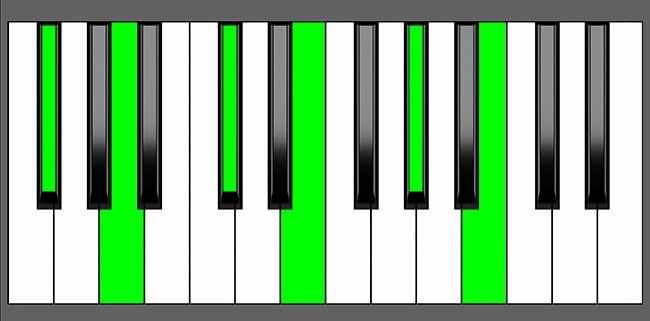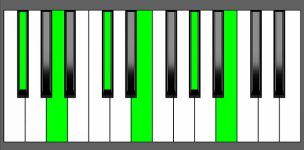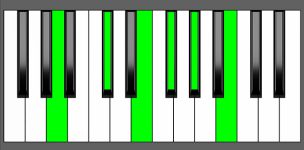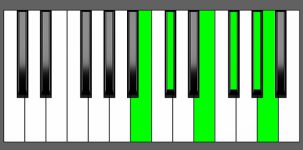Piano Diagram of Gbm11 in Root Position

The Gbm11 chord is a six-note chord that includes the root note (Gb), the minor third (Bbb), the perfect fifth (Db), the minor seventh (Fb), the major ninth (Ab), and the eleventh (Cb). This chord is commonly used as a variation or modulation for minor 7th chords. Keep reading to learn something more about this chord.
Structure of Gbm11
Notes |
|---|
| Gb, Bbb, Db, Fb, Ab, Cb |
Intervals |
|---|
| R, m3, 5, m7, 9, 11 |
Playing Extended Chords on Piano
Extended chords are commonly used in piano playing, but they can be tricky to play in their entirety due to the large number of notes involved. To make these chords more manageable, pianists often omit certain notes, such as the root or the 5th. Another technique is to split the chord between both hands, playing either full or partial chords in each hand.
How to play a Gbm11
For instance, in this scenario, you may opt to play a simplified version of Gbm11 by omitting the 5th and 9th notes. This way, you will only need to play the root note Gb (which can be played using your left hand), the minor 3rd Bbb (A), the minor 7th Fb (E), and the 11th note Cb (B) with your right hand.
Gb + Bbb, Fb, Cb
However, even when notes are omitted or split between hands, extended chords can still create complex and dense harmonies. When these chords are inverted, the resulting clusters of notes can be particularly challenging to voice effectively.
Gbm11 Chord Inversions
The Gbm11 chord has a total of 5 inversions:
| Root Position: | Gb | Bbb | Db | Fb | Ab | Cb |
| 1st Inversion: | Bbb | Db | Fb | Gb | Ab | Cb |
| 2nd Inversion: | Db | Fb | Gb | Ab | Bbb | Cb |
| 3rd Inversion: | Fb | Gb | Ab | Bbb | Cb | Db |
| 4th Inversion: | Ab | Bbb | Cb | Db | Fb | Gb |
| 5th Inversion | Cb | Db | Fb | Gb | Ab | Bbb |
Piano Keyboard Diagrams
Chord Inversion on Piano
Understanding chord inversions is an essential aspect of music theory as it helps to explain how chords are constructed and used in progressions. When playing chord inversions on a piano, it’s important to keep in mind that the diagrams used to illustrate the order of notes may not always be practical to play.
To achieve the proper chord voicings on a piano, you need to distribute the notes of the chord across various octaves and positions on the keyboard. This often means that the basic shape of the chord’s inversions shown in diagrams may not be the most convenient or comfortable way to play the chord.
While chord inversion diagrams can be useful in comprehending the structure and sequence of notes in a chord, it’s recommended to experiment with different voicings and fingerings to find the most efficient and comfortable way to play the chord while still preserving its intended harmonic function and sound.
Music Theory and Harmony of Gbm11
The Gbm11 chord is a diatonic extension of Gbm7. While it can be substituted for the Gbm7 chord in any position, it is commonly used in conjunction with it. Nonetheless, it’s worth noting that certain positions may not be as effective when substituting Gbm11 for Gbm7.
Building the Gbm11 Chord: Different Approaches
Starting from the Gb Major Scale
To build a minor 11th chord, you would use the root note, the minor third, the fifth, the minor seventh, the major ninth, and the eleventh from a minor scale. However, for educational purposes, it may be clearer to demonstrate its construction using a major scale, as it better illustrates the relationship between intervals and their qualities.


To create a Gbm11 chord, apply the formula R, m3, 5, m7, 9, 11 in the following manner:
- Begin with the Root note, which is Gb.
- Select the 3rd interval, which is Bb, and then subtract a half-step to get the minor 3rd Bbb (which is a natural A but we call it Bbb – “B double flat” – to preserve the basic interval structure of the chord).
- Add the 5th interval, which is Db.
- Add the minor 7th interval, which is the 7th (F) less a half-step, Fb (E).
- Add the major 9th which is Ab.
- Lastly, add the 11th Cb (B), which is a 4th interval at the higher octave.
By following this simple formula, you can create a minor 11th chord from any major scale.
by Combining Intervals
One method to create a minor 11th chord is by combining specific intervals – a minor 3rd, a major 3rd, a minor 3rd, a major 3rd, and a minor 3rd. This is the formula:
m3 + 3 + m3 + 3 + m3 = minor 11th Chords
- To create a Gbm11 chord, we start with the root note Gb and then add a minor 3rd interval, which is equivalent to moving up three half-steps from Gb, resulting in the note Bbb.
- Following this, we include a major 3rd interval by moving three half-steps up from Bbb (A), which leads to the note Db.
- This pattern is continued by adding another minor 3rd interval, which brings the note Fb (E), followed by a major 3rd interval, leading to the note Ab.
- Lastly, we add the 11th note Cb (B), which is found by moving up a minor 3rd from Ab, to complete the chord.
by Combining Chords
Another way to create minor 11th chords is to combine a minor triad with the major chord based on its minor 7th. For example, to build a Gbm11 chord, you can mix a Gb minor triad (Gb, Bbb, Db) with an Fb Major chord (Fb, Ab, Cb).
Gb minor + Fb Major = Gbm11
When played simultaneously, these two chords form a Gbm11 chord (Gb, Bbb, Db, Fb, Ab, Cb).
How to Use Gbm11 in a Chord Progression
The Gb minor 11th is an extension of the Gb minor 7th, with the addition of an extra 9th and an 11th note. This makes it a much fuller, more complex, and richer chord than Gbm7.
In this post, we will focus on the most common uses of the Gbm11 chord. The tables of the major and natural minor scales below include the Gb minor 7th chord, which can be substituted or complemented by a Gb minor 11th chord.
Gbm11 in Theoretical Keys
All keys that involve a Gb minor chord are considered theoretical. In these cases, it is common practice to refer to their enharmonic equivalent keys for simplicity and practicality.
on Natural minor Scales
| Minor Scales | i | ii | III | iv | v | VI | VII |
|---|---|---|---|---|---|---|---|
| Gb = F# | F#m7 ⇒ F#m11 = Gbm11 | G#m7b5 | A Maj7 | B min7 | C# min7 | D Maj7 | E7 |
| Db = C# | C# min7 | D#m7b5 | E Maj7 | F#m7 ⇒ F#m11 = Gbm11 | G# min7 | A Maj7 | B7 |
| Cb = B | B min7 | C#m7b5 | D Maj7 | E min7 | F#m7 ⇒F#m11 = Gbm11 | G Maj7 | A7 |
- Tonic chord in F# minor as F#min11
- Subdominant chord in C# minor as F#min11
- Non-diatonic Dominant chord in B minor as F#min11
on Major Scales
| Major Scales | I | ii | iii | IV | V | vi | vii |
|---|---|---|---|---|---|---|---|
| Fb = E | E Maj7 | F#m7 ⇒ F#m11 = Gbm11 | G# min7 | A Maj7 | B7 | C# min7 | D#m7b5 |
| Ebb = D | D Maj7 | E min7 | F#m7 ⇒ F#m11 = Gbm11 | G Maj7 | A7 | B min7 | C#m7b5 |
| Bbb = A | A Maj7 | B mi7 | C# min7 | D Maj7 | E7 | F#m7 ⇒ F#m11 = Gbm11 | G#m7b5 |
- Supertonic chord in E Major as F#min11
- Non-diatonic Mediant chord in D Major as F#min11
- Submediant chord in A Major as F#min11
Gbm11 in Gb minor
Gbm11 in Db minor
Gbm11 in Cb minor (Non-Diatonic)
Gbm11 in Fb Major
Gbm11 in Ebb Major (Non-Diatonic)
Gbm11 in Bbb Major
Alternative Gbm11 Nomenclature
- Gb -11
- Gb m11
- Gb -7/11
- Gb min11
- Gb m11th
- Gb min11th
- Gb min7/11
- Gb m7/9/11
- Gb minor 11
- Gb minor 11th
- Gb minor eleventh
- Gb minor ninth eleventh
- Gb minor seventh ninth eleventh





